

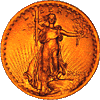 Collectors
Corner
Collectors
Corner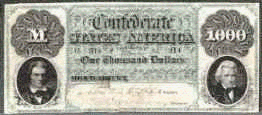

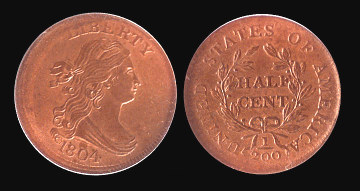
Half
Cents
The half cent was one of the first coins authorized by Congress on April 2, 1792. Designed by Adam Eckfeldt and first issued in 1793, it was minted at the Phildelphia Mint on and off until 1857. It was made of copper and had a weight of 6.74 grams. It is the smallest-denomination
coin this country has ever issued. Its low buying power and large size 22mm (it is slightly
smaller than a quarter) contributed to its unpopularity, in spite of the deflated
prices of its day. They discontinued production of the Half Cent by the Act of February 21, 1857.
There are five major varieties of this coin.
(1) Head facing Left 1793: Designer Adam Eckfeld
(2) Head facing right 1794-1797: Designers, 1794 Robert Scot & 1795-1797 John Smith
(3) Draped Bust 1800-1808: Designer, Robert Scot
(4) Classic Head 1809-1836: Designer, John Reich
(5) Cornet Head 1840-1857: Designer, Christian Gobrecht
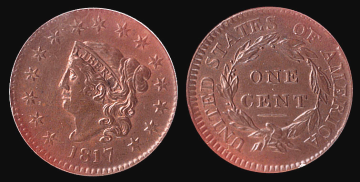
Large
Cents
Large cents were made from 1793 to 1857 except for the year of 1815 when there was a copper shortage. Large Cents along with Half Cents were the first coins to be minted under the authority of the United States Government that set laws stating that the Large Cent should weigh two times as much as the Half Cent. Somewhat larger than a quarter,
the large cent lasted untill 1857, the victim of its own weight (bulky) and high
production cost. Like the half cent, it was minted in Phildelphia and was made of copper.
There are seven major varieties of the Large Cent.
(1) Chain, 1793: Designer Henry Voigt
(2) Wreath, 1793: Designer Adam Eckfldt
(3) Liberty Cap, 1793-1796: Designer Joseph Wright
(4) Draped Bust, 1796-1807: Designer Robert Scot
(5) Classic Head, 1808-1814: Designer John Reich
(6) Coronet Head, 1816-1839: Designer Robert Scot
(7) Braided Head, 1840-1857: Designer Christian Gobrecht
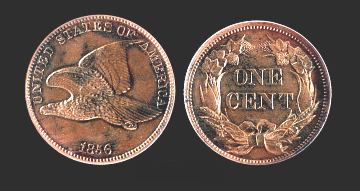
Flying
Eagle Cent
The 1856 flying eaglt cent was minted as a pattern coin to show Congress how a nickel cent would look & only 1000-2000 were produced. Starting regular production in 1857 and showing an eagle in flight on the front and the Laurel wreath around ONE CENT on the reverse, the Flying Eagle Cent lasted for a whole two years, untill 1858
when the Mint decided to change the obverse(front) of the cent starting in 1859. The resultant coin was and still is one of the most
attractive minor coins and one of the most popular coins this nation has ever produced.
Designed by James B. Longacre and composed of .880 copper & .120 nickel which weighed 4.67 grams. During the minting year 1858 two varieties were minted. The large letter type (A / M in America connected) and the small letter type with the (A / M seperated).
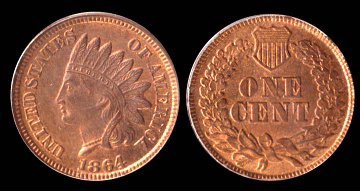
Indian
Head Cent
First issued in 1859 with a picture representing Lady Liberty wearing a Indian headdress on the front of the coin. (many people thought this was a real Indian girl). The first year had an Laurel wresth on the back that the Mint changed to an oak wreath the following year. Also1860 a small shield was added at
the top of the wreath. The designer of this beautiful coin was James B. Longacre.The composition remained the same as that of the flying eagle of .880 copper & .120 nickel with a weight of 4.67 grams.
The nickel alloy gave these coins a whitish appearance. During 1864 the composition
was changed to copper, tin and zinc. The coin was also made lighter.
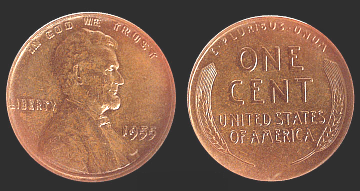
The
Lincoln Cent
Issued to commemorate the hundredth anniversary of Abraham Lincoln's
birthday, the Lincoln cent is the first cent to bear the motto: "In God We Trust."
It is also the first circulation coin bearing the likeness of a president of the
United States. The obverse shows a profile of Lincoln; the reverse shows wheat ears. The coin weighted 3.11 grams and was made from .950 copper & .050 tin and zinc. Anyone who has collected coins for even a short while will hear about
the "1909 S VDB." Most collectors would be able to complete their series
collection if it weren't for this and a few almost-as-scarce Lincolns. The coin became
scarce because the initials of the designer, Victor D. Brenner, were ordered removed
from the coin a few months after it had been in production. When the order was received,
the Philadelphia Mint had already produced almost 28,000,000 coins. The San Francisco
Mint, however had produced only 484,000. (The Denver Mint did not produce any cents
in 1909.) This low mintage accounts for its high cost, although in 1930 it could
be purchased for 25 cents ! The initials "VDB" were restored in 1918,
only this time to the front of the coin. If you will look closely, you will find
them around the rim, by Lincoln's sleeve.
1943 Steel Cent-- Because of the
copper shortage in 1943, the Mint began producing cents made of steel -coated with zinc and weighting 2.70 grams. Often mistaken for dimes, steel cents lasted only that one year.
Shellcase
Cent-- The cents produced in 1944 and 1945 were made from salvaged shellcases.
Weighting 3.11 grams and made up of .950 copper & .050 zinc. Other than a slight difference in color, these cents proved as satisfactory as the
pre-war copper coins, which were resumed in 1946.
Memorial Cent--On
the 150th anniversary of Lincoln's birth in 1959, the wheat ears were dropped from
the reverse and the new design by Frank Gasparro of the Lincoln Memorial was placed there. From 1959-1962 the cents were made up of .950 copper & .050 tin and zinc then from 1963-1982 they took out the tin and it was only .950 copper & .050 zinc.
1982 What A Year-- The composition of the cent went wild this year changing over to a copper plated zinc during the production year. The core was changed from (.950 copper & .050 zinc) to (99.2% zinc & .08% copper) with an outter plating of pure copper. Total weight went from 3.11 grams to 2.5 grams. The easist way to tell the difference of thses two cents is by their weight. The cents were minted by all three mints so there ended up being 7 different cents counting the mintmarks for this year. (no-mintmark Phildelphia, "D" mintmark Denver & "S" mintmark San Francisco.
Starting in 1983 we went back to 2.5% copper and 97.5% zinc with the normal weight of 2.50 grams. It looks as if this venerable coin will be around forever, since it takes an act of the Congress to change the design of a coin. We are still using this design today.
webmasters note: I know there has been a lot of talk over the years about doing away with the cent, but all I can say is that these are the first coins I collected as a kid and my son started his collection with cents as probably everyone who has ever collected coins. Cents are one of the most collected coins in this hobby today, and I hope they will be for our Grandchildren & their kids in years to come. just a thought :-)
< Back to last Page >*<go to Next Page >



www.diskworks.com

2-14-1998
Page Design by Sleepy
sleepy@diskworks.com
Copyright © 1997-2003, collectorscorner.org
All Rights Reserved.....